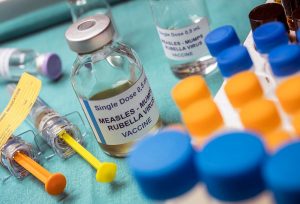The word went out late last month throughout Utah — if you’ve got a spare set of aluminum crutches lying around, you should donate them to your local hospital.
An international shortage of aluminum has caused delays in shipments of crutches and walkers, so Utah hospitals banded together for #LeanOnUtah — a community drive to collect gently used durable medical supplies.
No patients have yet gone without the crutches and walkers they need, but health care leaders saw potential trouble ahead and have acted to head it off, said Glen Beeby, spokesman for Intermountain Healthcare, a Utah-based not-for-profit system of 24 hospitals.
“Due to the uncertainty in the supply chain we wanted to make sure we were prepared as we went into the busiest part of the year for orthopedic surgeries,” Beeby said. “We knew Utahns would want to step up to help their neighbors.”
Global supply chain shortages are affecting U.S. health care in often unexpected ways, as doctors and hospitals find themselves scrounging for medical supplies and pharmaceuticals that wind up in short supply for a number of different reasons.
Virtually all U.S. hospitals and health care systems (99%) have reported challenges in procuring needed supplies, including shortages of key items and significant price increases, according to the health care consulting firm Kaufman Hall.
About 8 out of 10 said they suffered supply shortages and had to seek new vendors for supplies during the pandemic, a recent Kaufman Hall report found.
Shortages in raw materials and components hamper the production of both drugs and sophisticated medical devices. Manufacturing facilities struggle to keep up as COVID-19 sweeps through worker ranks. Labor shortages prevent medical products from being transported to the places where they’re needed most.
And an upcoming holiday season combined with pent-up consumer demand is likely to ensure that supply chain problems continue, as parts needed for medical monitors are instead put into video game systems and fancy 4K televisions, said Mike Schiller, director of supply chain at the Association for Health Care Resource & Materials Management.
“If you’re not going to work, there’s extra money in the family coffers. I have a $225 monthly train fare that I haven’t had to pay for 20 months, right?” Schiller said. “If you look at basic consumer spending, and now you’re coming into the holiday months, that type of consumer spending has been turbocharged as a result of everybody being sequestered for such an extended period of time. I want that new 80-inch OLED TV or the new PlayStation 5 or whatever it is.”
Drug shortages are nothing new. There are 109 drugs currently residing on a U.S. Food and Drug Administration list of ongoing shortages, and 195 on a list maintained by the American Society of Health System Pharmacists.
Small snags, big disruptions
And not everything on the list are true shortages, said Andrew Mulcahy, a senior policy researcher for health care at the RAND Corp.
“There are a couple of charts I’ve seen in papers showing this huge upswing in the number of shortages over the past decade, say, and it’s mostly a growth in these kinds of what we call ‘technical shortages,'” Mulcahy said. “The one particular box they wanted to buy was a little tricky to get, but patients were still able to get their drugs. It was hard for the pharmacists to get a specific size carton of something that they typically order, but they were able to find a substitute that was pretty close.”
But the COVID-19 pandemic has created snags and disruptions in the global supply chain that ripple outward, much as the flapping of a butterfly’s wings might contribute to a storm system on the other side of the world.
“Drugs used in the U.S. involve inputs from all over the world,” Mulcahy said, referring to raw materials. “A lot of those chemical inputs are manufactured in India and China, and they’re shipped to the U.S. That gets tied up in all of the disruptions around shipping that are affecting all industries right now.”
Shortages in aluminum, semiconductors, wood and paper pulp, and resin are disrupting supplies of medical devices, and these are often caused by different business sectors competing for the same raw materials, Schiller said.
Those shortages have led to uneven supplies of medical monitors, CT scan devices, packaging for medical supplies and gloves, Schiller said.
On top of that, energy shortages and high COVID infection rates among employees have caused manufacturing slowdowns at different facilities around the world, Schiller added.
Transportation also has caused kinks in the supply chain for needed medical supplies, said Nancy Foster, the American Hospital Association’s vice president of quality and patient safety policy.
“Over the last couple of months, we’ve also seen shortages in oxygen as hospitals that were experiencing a surge were using an extraordinary amount of oxygen compared to their normal usage,” Foster said.
“The challenge there was not actually in the availability of the oxygen, but was rather in the transportation of the oxygen to the hospitals,” Foster said. “That would require a hazardous material license for the driver,” and there are labor shortages of qualified truck drivers.
Shortages among pharmaceuticals tend to mostly affect sterile injectable drugs, and usually drugs that are older and less profitable, Mulcahy said.
Widely used drugs largely unaffected
“They tend to be drugs that are manufactured in and around the U.S., where companies maybe over time didn’t find it as profitable to make these older injectable drugs and they kind of got out of the business, to the point where there’s just one manufacturer left,” Mulcahy said. “Some disruption happens there, and then the supply really does dry up.”
On the other hand, supplies of widely used pills have remained surprisingly stable throughout the pandemic, Mulcahy said.
“For a lot of the more traditional prescription drugs, they are manufactured in very big batches and companies buy an awful lot of those inputs at one time and they typically have some months of stocks to work with before they run out,” Mulcahy said.
Most of the time, there are workarounds and substitutes for drugs, so that patients aren’t left in the lurch, Mulcahy said.
But in some cases, the substitutes just aren’t there.
One example is leucovorin, a medication typically given in combination with chemotherapy drugs, Mulcahy said.
“The go-to substitute is a close riff on the same molecule that was also having supply chain issues at about the same time,” Mulcahy said.
The good news is that both industry and government are adapting to help resolve these problems quickly and protect patients, experts said.
“If there’s a silver lining that’s come out of COVID, it’s the collaboration across the health care field,” Schiller said. “You’re seeing a lot of local and community businesses step up and retool their manufacturing facilities to make supplies to help the hospitals.”
Government also has been playing a role in helping direct supplies to the manufacturers and health providers that need them most, Mulcahy said.
“The government’s in a unique position to facilitate some of that,” Mulcahy said. “Another role is stockpiling and making sure there’s enough drugs and PPE. That’s another way that government can buffer some of this, when a disruption happens, to buy a little time and give industry and other parts of the government time to step in and try to fix things.”
And finally, each community can pitch in and lend a hand, as happened in Utah.
“The funny thing is, I was in my closet and I saw a pair of crutches tucked away in the corner, aluminum crutches,” Schiller said, discussing the Utah shortage. “I’m like, ‘interesting, I wonder if I should see if anybody needs those.'”
More information
The American Society of Health System Pharmacists has more about how drug shortages are managed.
SOURCES: Glen Beeby, spokesman, Intermountain Healthcare; Mike Schiller, director, supply chain, Association for Health Care Resource & Materials Management; Andrew Mulcahy, senior policy researcher, health care, RAND Corp.; Nancy Foster, vice president of quality and patient safety policy, American Hospital Association; 2021 State of Healthcare Performance Improvement: COVID Creates a Challenging Environment, report, Kaufman Hall, October 2021
Source: HealthDay
Copyright © 2025 HealthDay. All rights reserved.

















